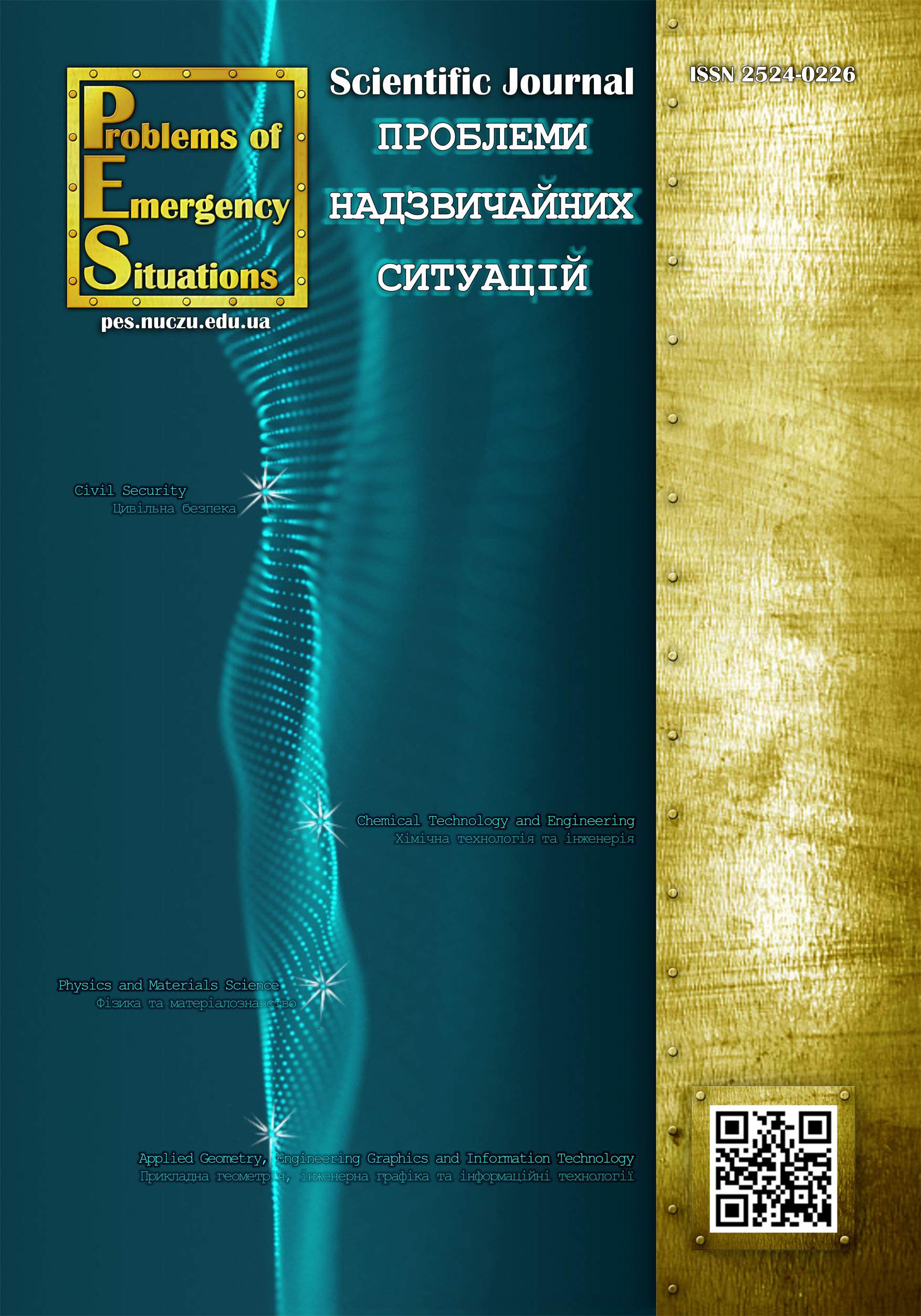Silicophosphate fireproof composition for building finishing materials
Lysak Nataliia
National University of Civil Protection of Ukraine
https://orcid.org/0000-0001-5338-4704
Skorodumova Olga
National University of Civil Protection of Ukraine
https://orcid.org/0000-0002-8962-0155
Chernukha Anton
National University of Civil Protection of Ukraine
https://orcid.org/0000-0002-0365-3205
Sharshanov Andrew
National University of Civil Protection of Ukraine
https://orcid.org/0000-0002-9115-3453
Goncharenko Yana
National University of Civil Protection e of Ukraine
https://orcid.org/0000-0002-1766-3244
Shcherbak Serhii
National University of Civil Protection of Ukraine
http://orcid.org/0000-0003-1133-0120
DOI: https://doi.org/10.52363/2524-0226-2024-40-6
Keywords: silica, fire-resistant coatings, phosphate buffers, building materials, heat resistance, fire resistance, wood, expanded polystyrene
Аnnotation
The composition of silicophosphate composition based on liquid glass for fire protection of building finishing materials has been developed. The compositions were prepared by mixing aqueous solutions of liquid glass and acetic acid with the addition of phosphate buffer solutions with a pH of 6–8. The phase composition of the experimental compositions was investigated by infrared spectroscopy and the formation of Si–O–P bonds was established, which indicates the incorporation of phosphate ions into the siloxane framework of polysilicic acid gels. It was established that the polycondensation mechanism is influenced by the pH value of the phosphate buffer solution, as well as its content. The use of a buffer solution with a pH of 6 leads to the initialization of mainly net polycondensation in liquid glass sols. Increasing the pH to 7–8 ensures linear polycondensation of polysilicic acid, which increases the homogeneity of the gel coating, provides elasticity, and increases its fire-retardant effect. Conducted fire tests showed that the best fire-resistant properties have systems with a buffer solution content of 20–25 % with a pH of 7, which provide maximum resistance to fire and minimal loss of mass of samples during exposure to high temperatures. For such compositions, the 1st group of flame retardant efficiency is established, and the treatment of wood samples with them allows the material to be transferred to the "high-flammability" group. Extruded polystyrene samples covered with the developed compositions do not burn, the absence of burning drops is noted. The obtained results emphasize the prospects for the further development of such systems for the protection of building materials.
References
- Zhang, C., Jiang, Y., Li, S., Huang, Z., Zhan, X., Ma, N., Tsai, F. (2022). Recent trends of phosphorus-containing flame retardants modified polypropylene composites processing. Heliyon, 8(11), e11225. doi: 10.1016/ j.heliyon.2022.e11225
- Varganici, C., Rosu, L., Bifulco, A., Rosu, D., Mustata, F., Gaan, S. (2022). Recent advances in flame retardant epoxy systems from reactive DOPO–based phosphorus additives. Polymer Degradation and Stability, 202, 110020. doi: 10.1016/j.polymdegradstab.2022.110020
- Zheng, T., Wang, W., Liu, Y. (2021). A novel phosphorus‐nitrogen flame retardant for improving the flame retardancy of polyamide 6: Preparation, properties, and flame retardancy mechanism. Polymers for Advanced Technologies, 32(6), 2508–2516. doi:10.1002/pat.5281
- Yan, Y., Liang, B. (2019). Flame-retardant behavior and mechanism of a DOPO-based phosphorus–nitrogen flame retardant in epoxy resin. High Performance Polymers, 31(8), 885–892. doi:10.1177/0954008318805794
- Giraudo, M., Dubé, M., Lépine, M., Gagnon, P., Douville, M., Houde, M. (2017). Multigenerational effects evaluation of the flame retardant tris(2-butoxyethyl) phosphate (TBOEP) using Daphnia magna. Aquatic Toxicology, 190, 142–149. doi: 10.1016/j.aquatox.2017.07.003
- Bolshova, T., Shvartsberg, V., Shmakov, A. (2021). Synergism of trimethylphosphate and carbon dioxide in extinguishing premixed flames. Fire Safety Journal, 125, 103406. doi: 10.1016/j.firesaf.2021.103406
- Chupeau, Z., Bonvallot, N., Mercier, F., Bot, B. L., Chevrier, C., Glorennec, P. (2020). Organophosphorus Flame Retardants: A global review of indoor contamination and human exposure in Europe and epidemiological evidence. International Journal of Environmental Research and Public Health, 17(18), 6713. doi: 10.3390/ijerph17186713
- Giraudo, M., Douville, M., Houde, M. (2015). Chronic toxicity evaluation of the flame retardant tris (2-butoxyethyl) phosphate (TBOEP) using Daphnia magna transcriptomic response. Chemosphere, 132, 159–165. doi: 10.1016/j.chemosphere.
2015.03.028 - Wang, K., Huang, W., Tian, Q., Tu, C., Yang, C., Yan, W. (2024). Multiple synergistic effects of silicon-containing flame retardants and DOPO derivative enhance the flame retardancy of epoxy resin. Polymer-Plastics Technology and Materials, 63(10), 1294–1305. doi: 10.1080/25740881.2024.2328617
- Lysak, N., Skorodumova, O., Chernukha, A. (2023). Development of a fire-proof coating containing silica for polystyrene. Problems of Emergency Situations, 2(38), 192–202. doi: 10.52363/2524-0226-2023-38-10
- Skorodumova, О., Tarakhno, O., Chebotareva, O., Bajanova, K. (2022). Silicon protective coatings for textile materials based on liquid glass. Problems of Emergency Situations, 1(35), 109–119. doi: 10.52363/2524-0226-2022-35-8
- DSTU 4479:2005 Rechovyny vohnezakhysni vodorozchynni dlia derevyny. Zahalni tekhnichni vymohy ta metody vyprobuvannia. Chynnyi z 01.10.2006. Кyiv: Derzhspozhyvstandart Ukrainy, 2006, 17.
- DSTU 8829:2019. Pozhezhovybukhonebezpechnist rechovyn i materialiv. Nomenklatura pokaznykiv i metody yikhnoho vyznachennia. Klasyfikatsiia. Chynnyi z 01.01.2020. Vyd. ofits. Kyiv: UkrNDNTs, 2020, 75.
- Karan, R., Pal, P., Maiti, P., Das, K. (2021). Structure, properties and in-vitro response of SiO2-Na2O-CaO-P2O5 system, based glass-ceramics after partial replacement of Na2O by Li2O. Journal of Non-Crystalline Solids, 556, 120554. doi: 10.1016/j.jnoncrysol.2020.120554
- Zribi, M., Baklouti, S. (2021). Investigation of phosphate based geopolymers formation mechanism. Journal of Non-Crystalline Solids, 562, 120777. doi: 10.1016/j.jnoncrysol.2021.120777
- Stýskalík, A., Škoda, D., Moravec, Z., Babiak, M., Barnes, C. E., Pinkas, J. (2015). Control of micro/mesoporosity in non-hydrolytic hybrid silicophosphate xerogels. Journal of Materials Chemistry. A, Materials for Energy and Sustainability, 3(14), 7477–7487. doi: 10.1039/C4TA06823H














